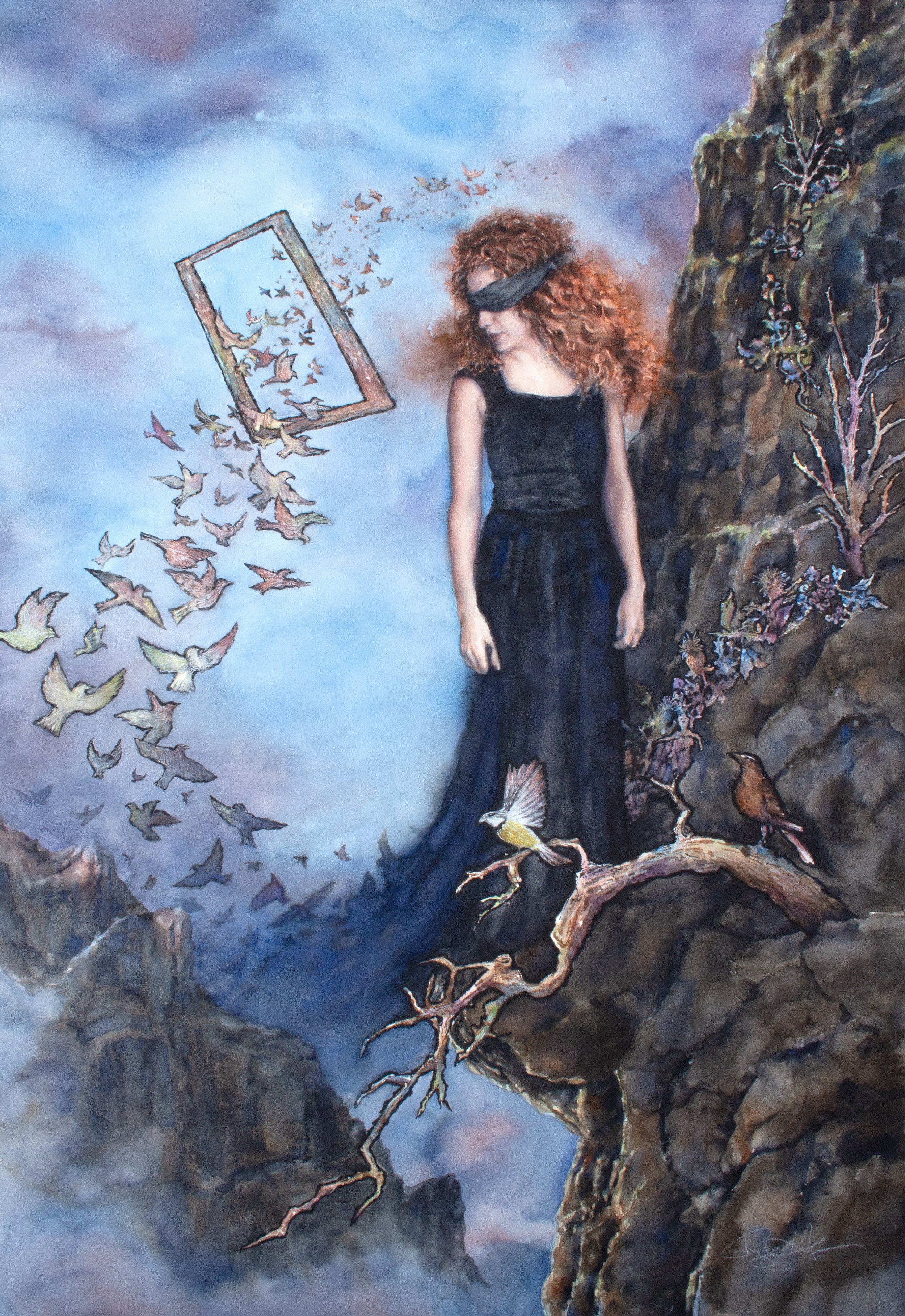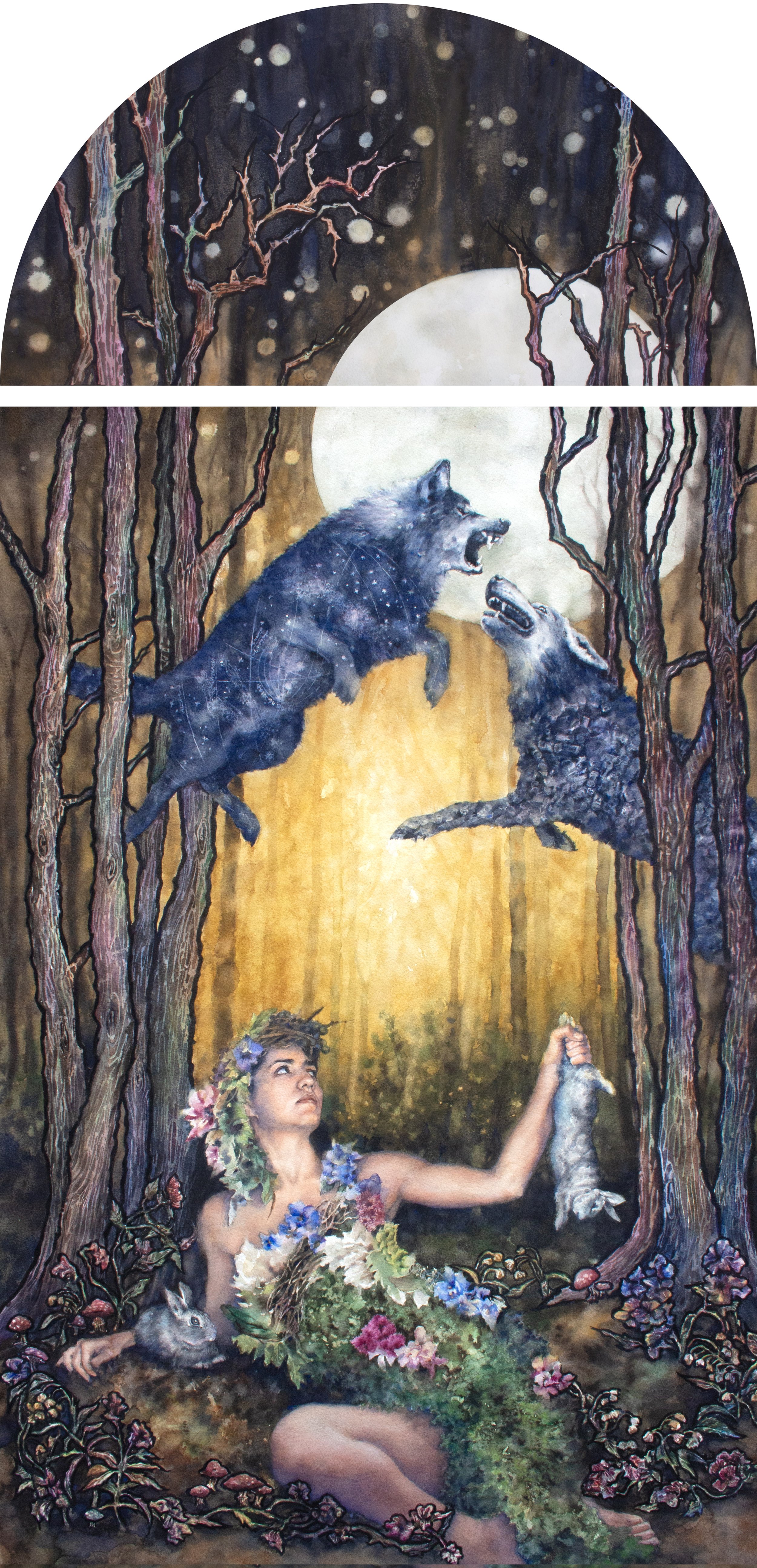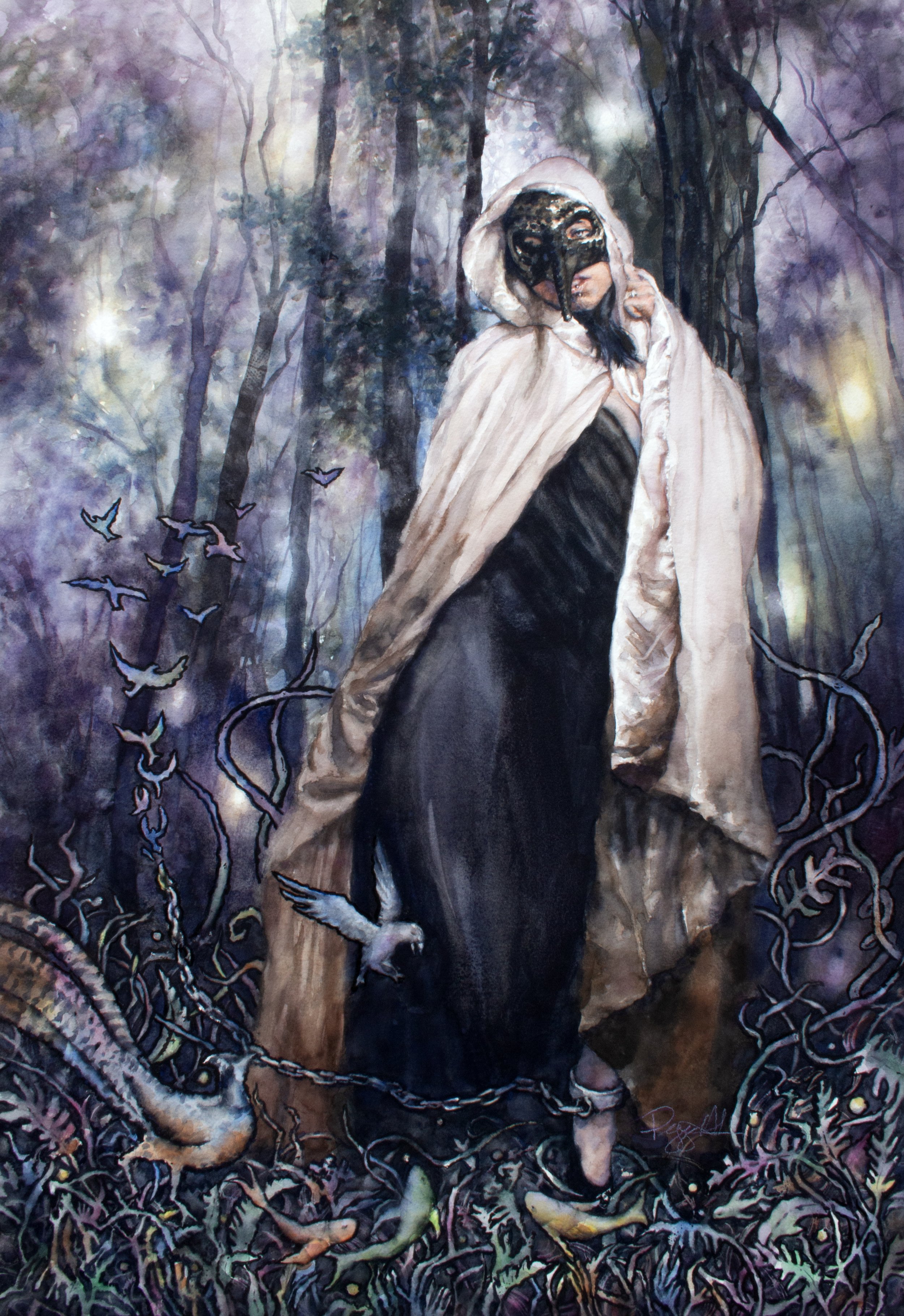Peggi Habets
Peggi Habets
Peggi Habets’ watercolor series presents an evocative collection that commands attention through its intricate symbolism, fluidity of form, and profound thematic exploration. Each piece serves as a tableau, inviting viewers into a narrative that is both deeply personal and universally resonant. In this critique, I will delve into the nuances of Habets' work, examining the technical mastery, thematic depth, and emotional impact of her watercolors.
At the heart of Habets’ watercolor paintings is a palpable tension between liberation and constraint. This duality is masterfully captured in "Blind But Seeing, Seeing But Blind," where the subject's blindfold suggests limitation, yet her posture and the surrounding birds convey a yearning for freedom. The floating frame within the composition serves as a gateway to an alternate reality, challenging our perceptions of sight and insight.
The theme of liberation continues in "Freedom in Flight," where the dynamic movement of birds in flight contrasts with the static posture of the woman, suggesting a complex narrative of aspiration versus the gravity of reality. The contrast between the ephemeral birds and the solid, almost sculptural form of the woman creates a conversation between the tangible and the transient, the mortal and the eternal.
"No Fruits Without Roots" is a testament to the foundational necessity of heritage and personal growth. Here, Habets employs a rich palette to underscore the vibrant, life-giving force of nature. The roots are not just literal but metaphorical, suggesting the unseen work that goes into any creation or identity. The intricate detailing of flora and fauna around the central figure anchors the piece in a sense of organic growth and interconnectedness.
In "Tend to The Garden," Habets brings forth the concept of nurturing, with a central figure that exudes a quiet strength amidst a bountiful environment. The composition, crowned with a delicate arch, evokes the cyclical nature of care and cultivation. The intertwining of human and nature signifies the symbiotic relationship that sustains life, both literally and metaphorically.
"The Armored Heart" is a captivating blend of portraiture and floral imagery, presenting a poetic interplay between human beauty and nature's splendor. The focal point of the composition is a profile of a woman whose facial features are rendered with remarkable finesse, emphasizing a serene and contemplative expression. The artist's mastery of watercolor is evident in the subtle gradations of skin tones, which convey a soft and lifelike texture. Surrounding the subject's visage is an abundance of flowers, rich in vibrant blues, purples, and hints of pink. The blooms are depicted with a level of detail that is both impressive and delicate, each petal and leaf meticulously crafted to stand out in the lush assemblage. This floral arrangement is not merely an accessory but an armor, enveloping the woman in a protective embrace of natural beauty. The contrast between the organic forms of the flowers and the geometric ornamentation of the border adds a layer of visual interest. The border, with its ornate corners and deep hues, frames the central image with a touch of opulence, reminiscent of a treasured tapestry or an illuminated manuscript.
"The Armored Heart" is a testament to the artist's skillful use of watercolor to create depth, texture, and emotion. The choice of medium lends a dreamlike quality to the work, as colors flow into one another, much like memories and thoughts in the human mind. It's a celebration of the harmony between humanity and the natural world, a theme that is timeless and universally resonant. This painting stands as a striking watercolor painting that masterfully blends the organic with the ornamental, creating a visual metaphor for the resilience and complexity of the human spirit. At first glance, the viewer is greeted with a profusion of vibrant florals that cascade across the figure, a botanical armor that seems to grow from within, suggesting a symbiosis between nature and the human form. The use of watercolor is particularly effective in this piece, bringing a sense of delicacy and fluidity that is often associated with the medium. The artist skillfully manipulates the transparency of watercolors to build layers of petals and leaves, creating an almost tactile depth. The color palette is rich and varied, employing a multitude of blues, purples, and greens that evoke a sense of both tranquility and mystery. The intense purples and blues in the floral arrangement suggest a regal quality, akin to a cloak of nobility, while the subtle greens seem to signify growth and renewal.
The subject's profile is rendered with a strong sense of realism, providing a grounding contrast to the fantastical floral arrangement that adorns her. The profile is proud and contemplative, giving the subject a sense of dignity and poise. This is not a passive figure but one who carries her armor with purpose. Her gaze is directed outward, hinting at a narrative beyond the canvas, inviting the viewer to ponder the stories and experiences that have led to the construction of this floral armor. The border of the painting is another element of note, reminiscent of a tapestry with its intricate patterns and ornate corners. It frames the central image with a sense of tradition and craftsmanship, which complements the organic theme. The border also serves to contain the wildness of the florals, creating a juxtaposition between the controlled and the unrestrained aspects of nature. In "The Armored Heart," the artist not only showcases technical prowess with watercolor but also conveys a profound message about identity, protection, and the beauty of inner strength. It is a celebration of the resilience that comes from weathering life's challenges, much like the flowers that bloom in adversity. The composition as a whole is a testament to the power of art to encapsulate complex emotions and concepts in a single, beautiful tableau.
"The One You Feed" illustrates the internal battle between opposing forces within us. The duality of the wolves, one celestial and the other earthbound, is a visual representation of the inner conflict between our higher aspirations and our base instincts. The human figure, engaged in a floral and serene activity, becomes the battleground for these forces, symbolizing the choices we make in feeding one aspect of our nature over the other.
"The Second Arrow" presents a contemplative figure, seemingly impervious to the chaos around her. The metaphor of the second arrow, which represents the self-inflicted pain that follows an initial hurt, is nuanced by the serene expression of the figure, suggesting a transcendence of this self-inflicted suffering through inner peace or enlightenment.
"Transfiguration" is a masterclass in the use of light and shadow, where the human form is intertwined with the serpentine, suggesting a metamorphosis. This piece could be interpreted as an allegory for personal transformation, the shedding of old skins, and the embrace of change. The use of a cool palette interspersed with warm tones accentuates the sense of emerging into a new state of being.
"Unshackled to Logic" is a striking commentary on the limits of rationality. The figure, enshrouded in mystery and the surreal, is surrounded by elements that defy logical explanation. This painting challenges the viewer to embrace the illogical and the mysterious as integral parts of the human experience.
Technically, Habets' watercolor technique is exquisite. She manipulates the medium with precision and grace, creating textures that range from diaphanous to strikingly detailed.
Her command over the fluidity of watercolors is evident in the seamless gradients and the controlled bleeds which lend an ethereal quality to her work. The intentional use of the watercolor medium, known for its propensity to blend and flow, underscores the thematic elements of transformation and fluidity present throughout her series.
Habets' palette is rich and varied, employing both subdued and vibrant colors to guide emotional responses and underscore the narrative flow. Her choice of colors often reflects the core theme of the piece, whether it's the earthy tones grounding the subjects to their roots or the use of blues and purples to evoke a sense of the mystical and the profound.
In terms of composition, Habets displays a sophisticated use of space and structure. She often frames her subjects with natural elements, such as trees and animals, which serve to both isolate and connect the figures to the larger tableau. This framing technique draws the viewer's eye inward, creating an intimate space for contemplation while also suggesting a larger world beyond the canvas.
The recurring motifs of nature — from flora and fauna to celestial elements — are not mere background details but are integral to the conceptual framework of Habets’ art. They act as symbols for growth, transformation, and the cyclical nature of life. The birds, in particular, serve as a motif of freedom and aspiration, recurring in several pieces, each time offering a different facet of the theme.
Habets also demonstrates an acute awareness of the human form. Her figures are rendered with an attentiveness to anatomical detail, yet they transcend mere representation. The bodies in her paintings are often positioned in ways that convey psychological states, such as contemplation, resignation, or defiance. The expressiveness of these figures is further enhanced by the artist’s use of light and shadow, which adds depth and dimensionality to the subjects, imbuing them with a sense of presence and vitality.
Emotionally, Habets' work is deeply resonant. There is a palpable sense of introspection and emotional depth that invites the viewer to connect with the subjects on a personal level. The facial expressions of the figures, often pensive or serene, along with their sometimes surreal companions or adornments, suggest a rich inner life. Each piece seems to encapsulate a moment of profound personal significance, evoking empathy and reflection in the viewer.
The narrative aspect of Habets’ work is also noteworthy. Each painting tells a story, not through explicit action but through symbolic representation and emotional resonance. The stories are open-ended, encouraging the viewer to bring their interpretations to the experience. This interactive aspect of her art enriches the viewing experience, making each piece a personal journey for the viewer.
Habets' work can be seen as a commentary on the human condition. Themes such as the struggle between the self and the other, the search for balance between internal and external forces, and the quest for self-awareness are explored with sensitivity and insight. Her paintings do not shy away from complexity; instead, they embrace it, inviting viewers to acknowledge and contemplate the multifaceted nature of our existence.
The technical prowess of Habets is matched by her conceptual ambition. Her watercolors are not content with mere aesthetic appeal; they strive for a deeper engagement with the viewer. Each brushstroke and color choice is a deliberate step in crafting a narrative that is both personal to the artist and universal in its appeal. Peggi Habets’ watercolor series is a striking collection that stands out for its technical excellence, thematic depth, and emotional potency. Her work is a testament to the power of watercolor as a medium not just for representation but for profound expression. Each painting is a window into a story, a reflection of the human spirit, and an invitation to a dialogue with the self. Habets has crafted a body of work that is both a feast for the eyes and nourishment for the soul. Through her art, she challenges, comforts, and inspires, solidifying her place as a notable contemporary artist in the field of watercolor.
Peggi Habets stands out in the contemporary art scene with a style that is at once evocative, innovative, and deeply rooted in the narrative tradition of watercolor painting. Her pieces are a dance of color, light, and shadow, embracing the fluidity of the medium to tell stories that captivate and resonate with the viewer. Habets' work is not just about the aesthetic appeal of watercolor; it is about using this traditional medium to challenge and expand the boundaries of visual storytelling. One of the most striking aspects of Habets' style is her use of watercolor in a way that defies its traditional limitations. Watercolor is often considered a medium that is difficult to control, but Habets turns this into an asset. She uses its inherent unpredictability to create textures and layers that give her work an ethereal quality, infusing each piece with a sense of movement and life that is seldom seen in watercolor paintings. This innovative approach to the medium enables her to convey complex emotions and atmospheres, from the serene to the tumultuous, that draw the viewer into a vivid emotional landscape.
Habets' technical mastery allows her to achieve a range of depth and detail that is remarkable for watercolor. Her compositions often feature a delicate balance between sharp, intricate details and the loose, flowing backgrounds that characterize watercolor work. This juxtaposition creates a dynamic tension within her paintings, highlighting the focal points while allowing the eye to wander and explore the nuanced environments she constructs.
Her themes often revolve around the human condition, exploring narratives of freedom, growth, and internal struggle. These themes are depicted not just through the subjects themselves but also through the symbolic use of space and nature. Habets' work often incorporates elements of the natural world, which serve as metaphors for human experiences and emotions. This symbolic language enriches her paintings with layers of meaning, inviting viewers to delve deeper into the narrative and connect with the artwork on a personal level. Habets' compositions are noteworthy for their thoughtful use of negative space and the strategic placement of subjects within the frame. She often employs unconventional cropping and composition, which adds an element of surprise and modernity to her work. The figures in her paintings are sometimes placed off-center or partially obscured, which encourages viewers to engage more actively with the art, piecing together the story or emotion being conveyed. In terms of her placement within the contemporary art world, Habets' work represents a bridge between the traditional and the modern. While watercolor painting is a medium with a long history, her approach to it is fresh and contemporary. She aligns with the current trend in art that values emotional expression and storytelling, and her work resonates with a wide audience because of its accessibility and depth.
Habets is also contributing to the current dialogue about the place of representational and figurative art in a contemporary setting. At a time when abstract and conceptual art have been dominant, her focus on narrative and the human form is both a homage to classical art traditions and a statement of relevance for these themes in today's art world. Peggi Habets' watercolor paintings are a testament to the enduring power of storytelling through art. Her innovative techniques, coupled with her ability to evoke deep emotional responses, secure her position as a notable contemporary artist. Her work is a reminder that innovation in art is not just about breaking with tradition, but also about bringing new life and perspective to classical forms. Habets' paintings are not only visually striking but also intellectually and emotionally stimulating, making her a significant voice in the contemporary art scene.
By Marta Puig
Editor Contemporary Art Curator Magazine
Blind But Seeing, Seeing But Blind
Freedom in Flight.
No Fruits Without Roots w header
Tend to The Garden header
The Armored Heart
The One You Feed2 w header
The Second Arrow
Transfiguration w header
Unshackled to Logic












